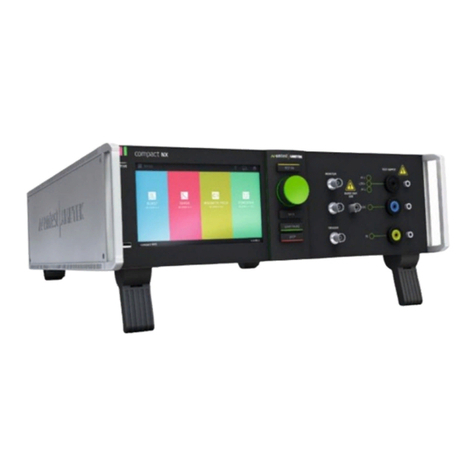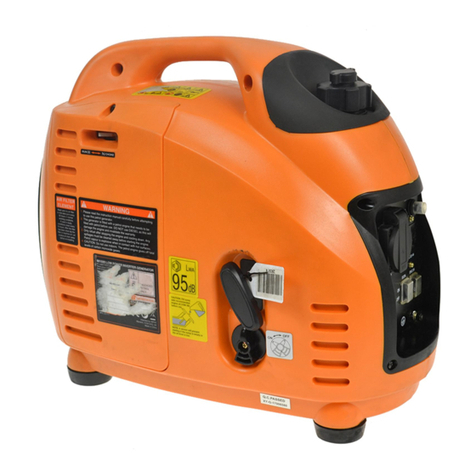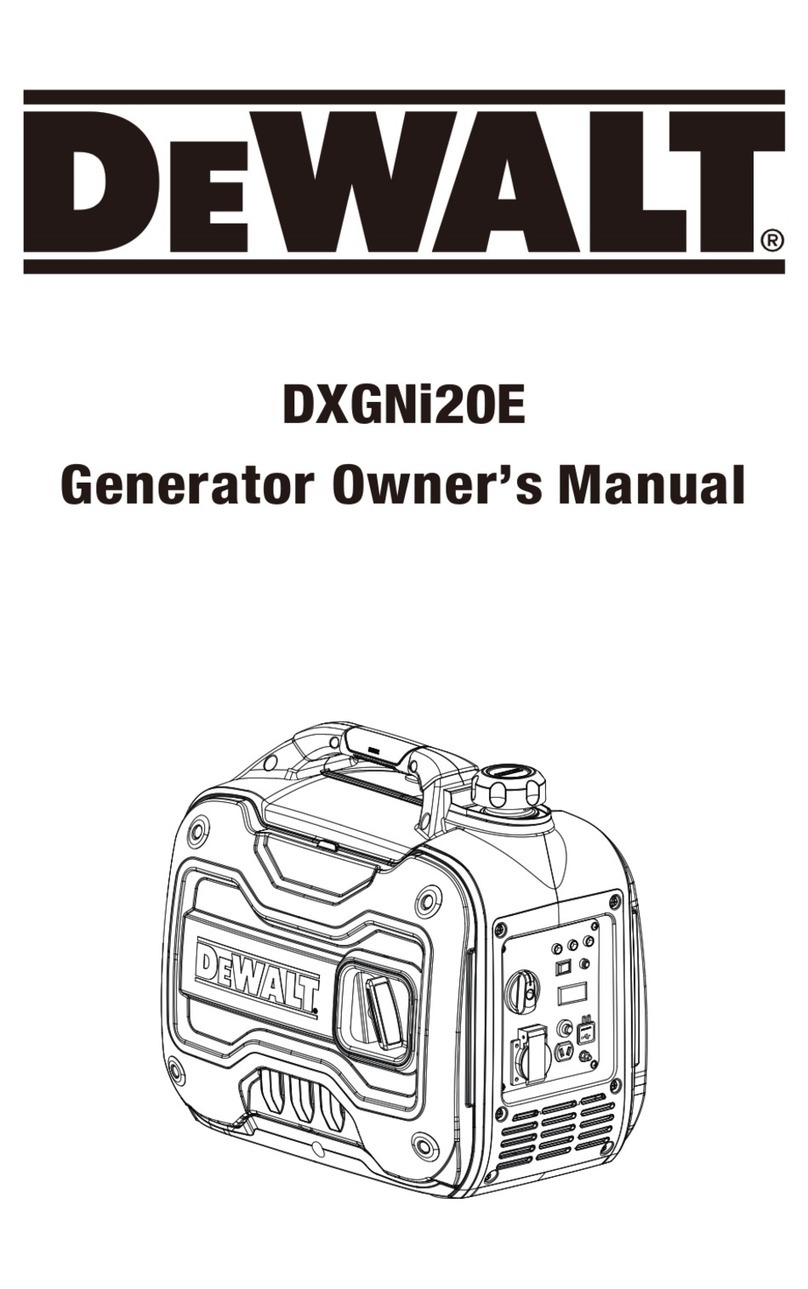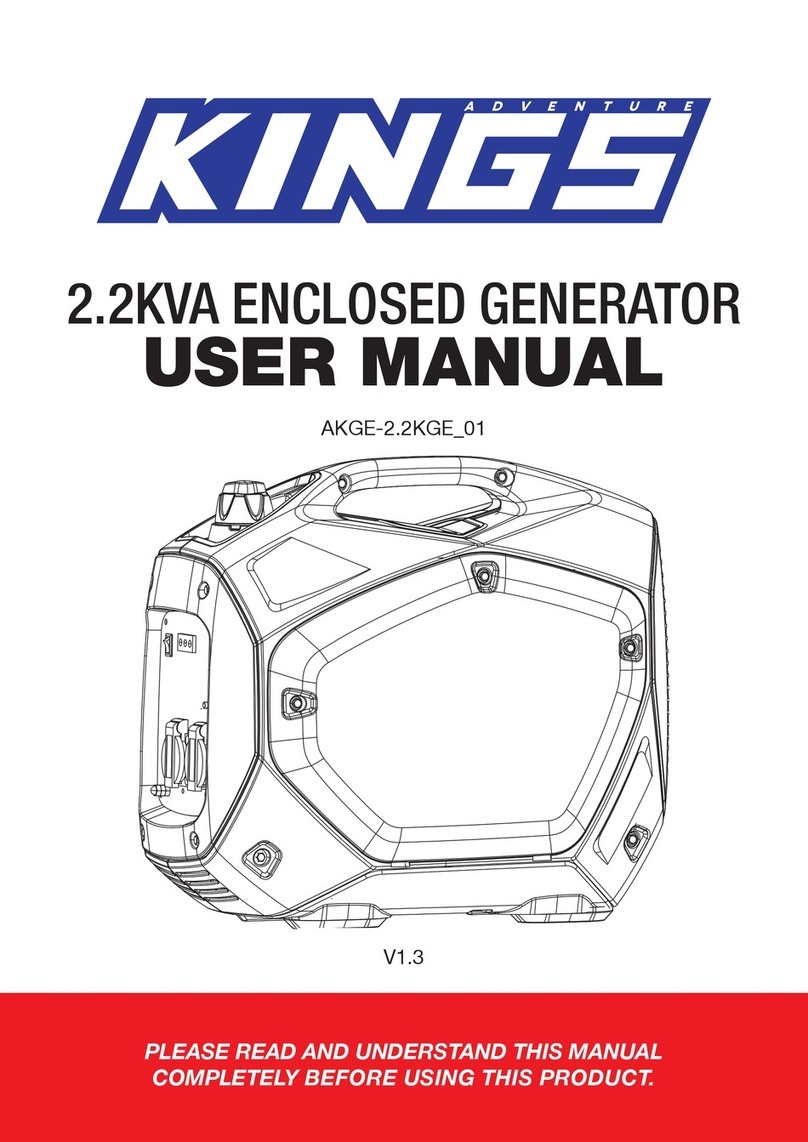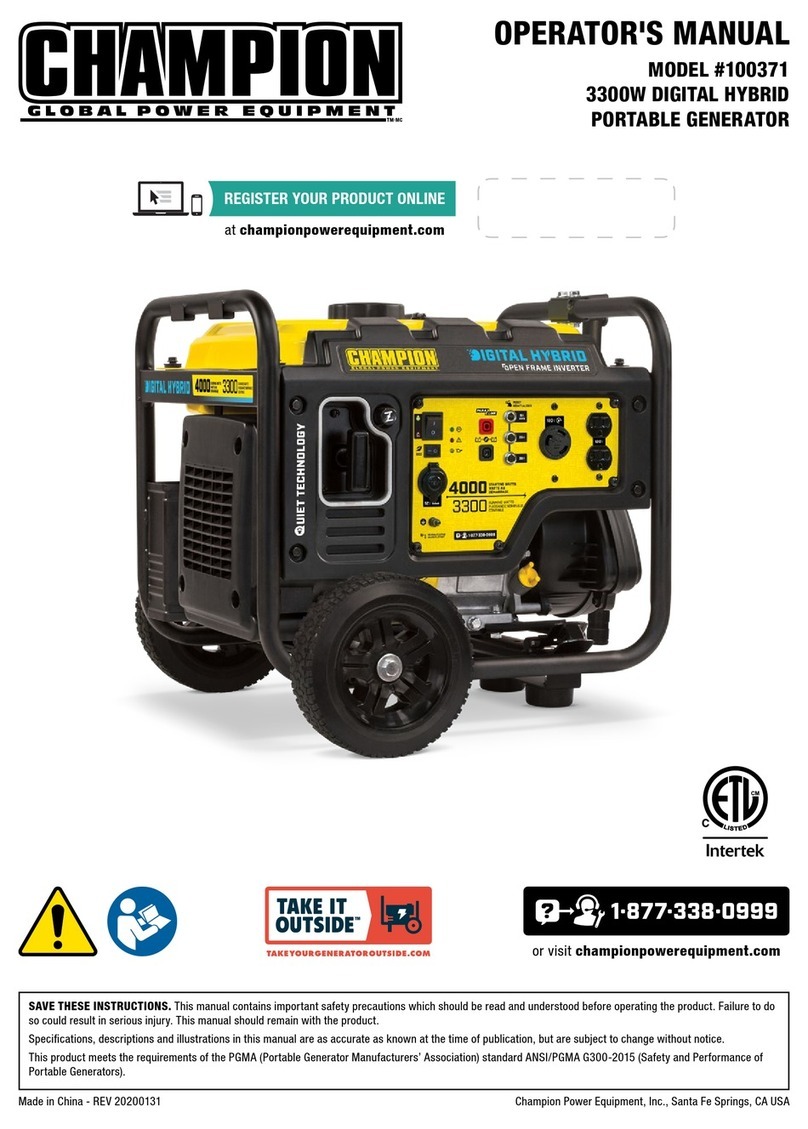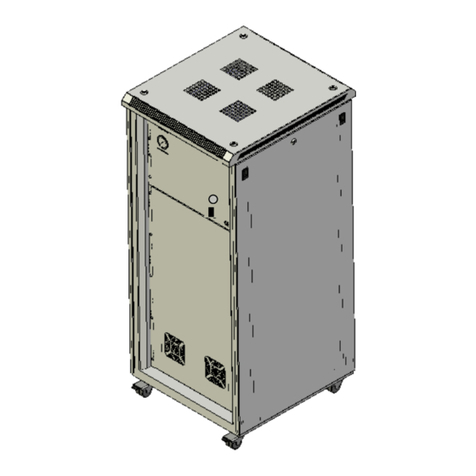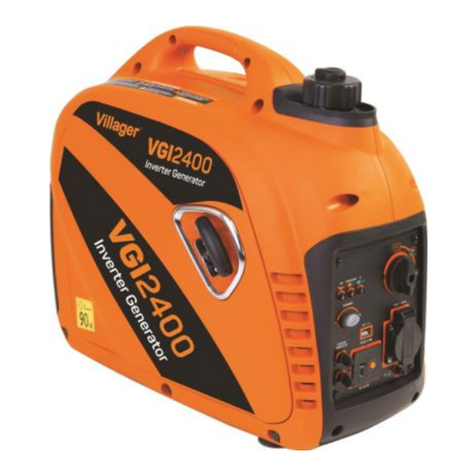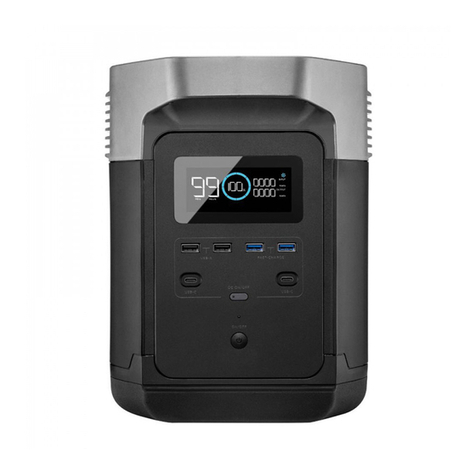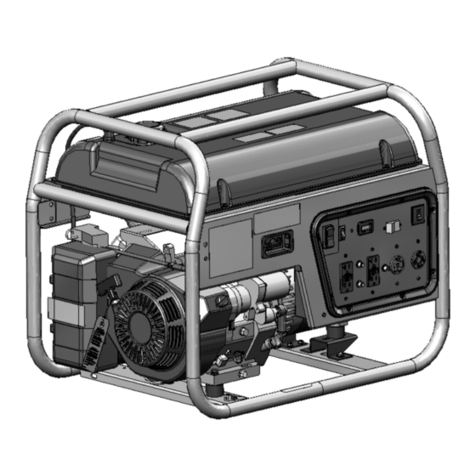Koshin GV-3000 User manual

High Performance Gasoline Generator
OPERATION MANUAL
12-11 065038401
12 Kami-Hachinotsubo Kotari, Nagaokakyo City, Kyoto 617-8511 JAPAN
TEL.+81-75-954-6111 FAX.+81-75-954-6119
[GV-3000・GV-3200・GV-7000S・GV-7600S]


INTRODUCTION
Thank you for purchasing a KOSHIN generator. This manual will provide you a basic
understanding of the operation and maintenance of this generator.
Please read it carefully.
We continually seek advancements in product design and quality. Therefore, while this
manual contains the most current product information available at the time of printing,
there may be minor discrepancies between your machine and this manual. We reserve
the right to make changes at any time without incurring any obligation
This manual should be considered a permanent part of this generator and should
remain with this generator when resold.
PLEASE READ AND UNDERSTAND THIS MANUAL COMPLETELYBEFORE
OPERATING THE MACHINE.
Important information is distinguished in this manual by the following notation:
Failure to follow “DANGER” instructions can result in severe
injury or death to the engine operator, a bystander or a person
inspecting or repairing the generator.
Failure to follow “WARNING” instructions can result in severe
injury to the engine operator, a bystander or a person
inspecting or repairing the generator.
A “CAUTION” indicates special precautions that must be taken
to avoid damage to the generator.
A NOTE provides key information to make procedures easier or
clearer.
CAUTION
NOTE
WARNING
DANGER

1
CONTENTS
SAFETY INFORMATION························································································2
COMPONENT IDENTIFICATION···········································································6
CONTROLS············································································································7
ENGINE SWITCH····························································································7
RECOIL STARTER··························································································7
FUEL VALVE···································································································7
CHOKE············································································································8
AC CIRCUIT BREAKER··················································································8
OIL WARNING SYSTEM ·················································································8
DC TERMINAL·································································································9
DC CIRCUIT BREAKER··················································································9
PRE-OPERATION CHECK ··················································································10
ENGINE OIL ··································································································10
REFUELING ··································································································11
GROUND (Earth)···························································································11
BATTERY·······································································································12
OPERATION ·······································································································13
STARTING THE ENGINE··············································································13
APPLICATION RANGE··················································································14
CONNECTION·······························································································15
STOPPING THE ENGINE ·············································································16
PERIODIC MAINTENANCE·················································································17
MAINTENANCE CHART ···············································································17
ENGINE OIL REPLACEMENT ······································································18
SPARK PLUG INSPECTION·········································································18
AIR FILTER····································································································19
CARBURETOR ADJUSTMENT·····································································19
FUEL VALVE··································································································20
FUEL TANK FILTER ······················································································20
STORAGE············································································································21
TROUBLESHOOTING·························································································23
SPECIFICATION ··································································································25
WIRING DIAGRAM······························································································26
························································30
INSTALLATION INSTRUCTIONS
WHEEL KIT AND HANDLE ASSEMBLY

2
SAFETY INFORMATION
OPERATOR RESPONSIBILITY
・ Be knowledgeable of how to use all generator controls, output receptacles and
connections.
・ Know ways to stop the generator operation quickly in case of emergency.
・ Person operating the generator must receive proper training and instructions.
・ No child should operate the generator without proper parental or adult instruction.
・ Keep children away from the area of operation.
・ Make sure the generator is on firm and level surface. Do not place on unstable
surface such as sand or snow. Fuel spillage may occur when generator is tilted or
overturned.
EXHAUST FUMES ARE POISONOUS
・ Never operate the engine in a closed area. It
may cause unconsciousness and death within
a short time. Operate the engine in a well
ventilated area.
FUEL IS HIGHLY FLAMMABLE AND POISONOUS
・ Always turn off the engine when refueling.
・ Never refuel while smoking or in the vicinity of
an open flame.

3
・ Take care not to spill any fuel on the engine or
muffler when refueling.
・ When operating or transporting the machine,
be sure it is kept it upright. If it tilts, fuel may
leak from the carburetor or fuel tank.
・ If you swallow any fuel, inhale fuel vapor, or
allow any to get in your eye(s), see your doctor
immediately. If any fuel spills on your skin or
clothing, immediately wash with soap and
water and change your clothes.
ENGINE AND MUFFLER MAY BE HOT
・ Place the machine so pedestrians or children
are not likely to touch the machine.
・ Avoid placing any flammable materials near
the exhaust outlet during operation.

4
・ Keep the machine at least 1 m (3 ft) from
building or other equipment, the engine may
overheat.
・ The engine and muffler remain hot for a while
after stopping the engine. Be careful not to
touch them.
・ Avoid operating the engine with a dust cover
on.
ELECTRIC SHOCK PREVENTION
・ Never operate the generator in wet conditions
such as in rain or snow.
・ Never touch the machine with wet hands, an
electrical shock will occur.

5
・ Be sure to ground the generator to the earth.
Use ground lead of sufficient current capacity.
Ground (earth) Lead Diameter : 0.12mm (0.005 in) / ampere
EX : 10 Ampere →1.2mm (0.05 in)
EXTENSION CORD NOTES
・ When using an extension cord, its total length should not exceed
60 meters for cross section of 1.5 mm2and
100 meters for cross section of 2.5 mm2or more.
Long extension cables will lower usable power due to resistance in extension cable.
・This extension cord should be protected by a tough flexible rubber sheath (IEC 245)
or the equivalent to withstand mechanical stresses.
CONNECTION NOTES
・ Do not connecting the generator to commercial power outlet.
・ Do not connecting the generator in parallel with any other generator.
Before the generator can be connected to a building’s
electrical system, a licensed electrician must install an
isolation (transfer) switch in the building’s main fuse box. The switch is the
connection point for generator power and allows selection of generator or main
line power to the building. This will prevent the generator from charging the main
power line (backfeeding) when the main power supply has failed or has been
turned off for line repair. Backfeeding can electrocute or injure line maintenance
personnel. Also, generator and building electrical system damage can occur
when normal operating power returns if unit is used without an isolation switch.
Correct
Incorrect
Incorrect
Correct
NOTE
WARNING
5

6
COMPONENT IDENTIFICATION
<PANEL>
GV-3000 GV-3200
GV-7000S GV-7600S
MUFFLER
AIR FILTER
CHOKE
LEVER
FUE
L
VALVE
RECOIL
STARTER GRIP
FUEL TANK CAP
OIL DRAIN
PLUG
OIL FILLER
CAP
VOLTAGE METER
SPARK PLUG CAP
AC RECEPTACLES
ENGINE SWITCH
DC CIRCUIT BREAKER
GROUND TERMINAL
PILOT LAMP
DC TERMINALS
AC CIRCUIT BREAKER
VOLTAGE METER
AC RECEPTACLES
ENGINE SWITCH
DC CIRCUIT BREAKER
GROUND TERMINAL
PILOT LAMP
DC TERMINALS
AC CIRCUIT BREAKER
VOLTAGE METER
AC RECEPTACLES
ENGINE SWITCH
DC CIRCUIT BREAKER
GROUND TERMINAL
PILOT LAMP
DC TERMINALS
AC CIRCUIT BREAKER
VOLTAGE METER
AC RECEPTACLES
ENGINE SWITCH
DC CIRCUIT BREAKER
GROUND TERMINAL
PILOT LAMP
DC TERMINALS
AC CIRCUIT BREAKER

7
CONTROLS
ENGINE SWITCH The engine switch controls the
ignition system to start and stop
the engine.
①ON :
Ignition circuit is switched on.
The engine can be started.
②OFF :
Ignition circuit is switched off.
The engine will not run.
③START :
Starting circuit is switched on.
The starter motor starts.
(GV-7000S, GV-7600S)
Take your hand off the switch immediately after the engine starts.
RECOIL STARTER To start the engine, pull slowly on the recoil starter
until it is engaged, then pull it briskly.
Do not allow the starter grip to snap back against the
engine, Return it gently to prevent damage to the
starter.
FUEL VALVE Before starting the engine, turn the fuel valve to “ON”
position so the fuel flows from the fuel tank to the
carburetor.
Be sure to return the fuel valve lever to the OFF
position after stopping the engine.
GV-3000
G
V
-3200
GV-7000S
G
V
-7600S
CAUTION

8
CHOKE When starting a cold engine, turn the choke lever to
CLOSE position.
It can be opened and closed by operating the choke
lever manually.
The choke is not required to start a warm engine.
AC CIRCUIT BREAKER
The AC circuit breaker turns off automatically when overload or if there is a short circuit.
Reduce the load to the specified generator rated output if the AC circuit breaker turns
off.
OIL ALERT SYSTEM
When the oil level falls below the lower level, the engine will stop automatically. (Though
the generator switch still remains in the ON position.)
Unless you refill with oil, the engine will not start again. Check the engine oil lever before
troubleshooting in other areas.
NOTE
GV-3000
・
GV-3200
GV-7000S
・
GV-7600S GV-7600S

9
DC TERMINALS The DC terminals may ONLY be used for charging
12V batteries for automotive use.
The terminal colored red is positive (+) terminal, and
colored black is negative (-) terminal.
DC CIRCUIT BREAKER The DC circuit breaker turns off automatically when
DC charging circuit is overloaded or the battery has
problem.
Press to reset the DC circuit breaker. After reducing
the load to the specified DC rated output
NEGATIVE TERMINAL (BLACK)
POSITIVE TERMINAL (RED)

10
PRE-OPERATION CHECK
Pre-operation checks should be made each time the generator is used.
ENGINE OIL
Engine oil is a major factor affecting engine performance and service life. Make sure the
engine oil is at the upper level of the oil filler hole. Add oil as necessary.
2-stroke gasoline engine oil or diesel engine oils will damage the engine.
Recommended engine oil
4-stroke gasoline engine oil
SF under API service classification
or SAE10W-30 (equivalent to SG class).
AMBIENT TEMPERATURE
Method of checking engine oil level:
1, Remove the oil filler cap and wipe the dipstick to clean it.
2, Check the oil level by inserting the dipstick into the filler neck without screwing it in.
3, If the level is low, add the recommended engine oil until level can reach the upper
mark on the dipstick.After adding, don’t forget to refit and screw the oil dipstick tight.
The generator has been shipped without engine oil. Fill with oil or it will not start.
CAUTION
NOTE
OIL LOWER LEVEL
OIL UPPER LEVEL
CAUTION

11
REFUELING
Check the fuel level gauge and make sure there is sufficient fuel in the fuel tank.
Recommended fuel: Unleaded gasoline
・ Fuel is highly flammable and poisonous. Check “SAFETY INFORMATION”
(See page 3) carefully before refueling.
・ Do not fill above the top of the fuel filter, or it may overflow when the fuel heats
up and expands.
・ Wipe any spilled fuel immediately.
・ After refueling, make sure the tank cap is tightened securely.
GROUND (Earth) Make sure to ground the generator to prevent
electrical shock. Connect the ground lead between
the ground terminal and the ground.
Check “SAFETY INFORMATION” on page 6.
WARNING
FUEL LEVEL
GAUGE
EMPTY
FULL
OPEN
CLOSE
FUEL TANK CAP
GROUND
TERMINAL
UPPER LEVEL

12
BATTERY
・ If improper operation, the battery may be explosive and may potentially hurt
persons nearby. Keep the fire and inflammable materials far away from the
battery.
・ The battery will release the explosive gas, please keep the fire far away from it.
Keep a good air ventilation condition when battery is being charged or used.
・ Clamp the red wire to the positive (+) terminal first, then the black wire to the
negative (-) terminal of the battery. Do not reverse these positions. Otherwise
serious damage may be caused to the generator set and battery.
・ Please read the enclosed user’s manual for proper usage of the battery you have
purchased.
WARNING
NOTE

13
OPERATION
The generator has been shipped without engine oil. Fill with oil or it will not start.
STARTING THE ENGINE
Before starting the engine, do not connect any electric devices.
1. Turn the AC circuit breaker to “OFF” position. The generator may be hard to start if a
load is connected.
2. Turn the fuel valve lever to the ON position.
3. To start a cold engine, move the choke lever to the CLOSED position. To restart
a warm engine, leave the choke lever in the OPEN position.
4. Turn the engine switch to the ON position.
5. Pull slowly on the recoil starter until it is engaged, then pull it briskly.
NOTICE
Do not allow the starter grip to snap back against the engine. Return it gently to prevent
damage to the starter or housing.
6. Turn the choke lever back to the “OPEN” position.
Turn the engine switch to the START position.
・ Take your hand off the switch immediately after the engine starts.
・ If the engine fails to start, release the switch, wait a few seconds, and then try
again. Each attempt should be as short as possible to preserve the battery. Do
not crank the engine more than 10 seconds on any one attempt.
CAUTION
Electric Starting Model (GV-7000S, GV-7600S)
NOTE
CAUTION

14
APPLICATION RANGE
Most motorized appliances require more than their rated wattage for start-up.
Please use the list below as reference.
AC
Power factor 1 0.8~0.95 0.4~0.75
DC
GV-3000 ~2000W ~1600W ~750W Rated voltage 12V
Rated current 8.3A
GV-3200 ~2300W ~1600W ~750W Rated voltage 12V
Rated current 8.3A
GV-7000S ~5000W ~4000W ~2000W Rated voltage 12V
Rated current 8.3A
GV-7600S ~5500W ~4000W ~2000W Rated voltage 12V
Rated current 8.3A
Application wattage is indicated when each device is used by itself.
Substantial overloading will switch off the AC circuit breaker. Exceeding the time limit for
maximum power operation or slightly overloading the generator may not switch the AC
circuit breaker OFF, but will shorten the life of the generator.
Limit operation requiring maximum power to 30 minutes.
Maximum power is:
GV-3000: 2.2kVA, GV-3200: 2.5kVA, GV-7000S:5.5kVA, GV-7600S:6kVA
For continuous operation, do not exceed the rated power.
Rated power is:
GV-3000: 2kVA, GV-3200: 2.3kVA, GV-7000S:5kVA, GV-7600S:5.5kVA
The total power requirements (VA) of all appliances connected must be considered.
Appliance and power tool manufacturers usually list rating’s information near the model
number or serial number.
Some precision equipment is voltage sensitive and may require a more uniform voltage
supply than portable generators provide. Examples include some medical equipment,
personal computers and some inverters that sense peak and RMS voltage values.
Consult the precision equipment vendor before relying on any portable generator to
provide power to such equipment.
NOTE
NOTE
CAUTION

15
CONNECTION
Direct Current (DC) OPERATION
Connecting the battery cables:
1. Before connecting the battery charging cable to a battery that is installed in a vehicle,
disconnect the vehicle ground battery cable from the battery negative (-) terminal.
A battery can explode if you do not follow the correct procedure, seriously injuring
anyone nearby. Keep all sparks, open flames, and smoking materials away from the
battery.
The terminal colored red is positive terminal (+),
and colored black is negative terminal (-).
Do not reverse these positions.
2. Connect the battery cables:
①Connect one end of the positive (+) battery
cable to the battery positive (+) terminal.
②Connect the other to the positive (+) DC
terminal.
③Connect one end of the negative (-) battery
cable to the negative (-) battery terminal.
④Connect the other to the negative (-) DC
terminal.
3. Disconnecting the battery cables:
①Disconnect one end of the negative (-)
battery cable from the negative (-) DC
terminal.
②Disconnect the other from the negative (-)
battery terminal.
③Disconnect one end of the positive (+)
battery cable from the positive (+) DC
terminal.
④Disconnect the other from the positive (+)
battery terminal.
①
② ④
③
DC CIRCUIT
BREAKER
WARNING
NEGATIVE TERMINAL (BLACK)
POSITIVE TERMINAL (RED)
①
②
④
③

16
Alternating Current (AC) OPERATION
・ Be sure all electric devices including the lines and plug connections are in
good condition before connecting to the generator.
・ Be sure any electric devices are turned off before plugging in.
・ Be sure the total load is within generator rated output.
・ Be sure the receptacle load current is within receptacle rated current.
・ Limit maximum power operation to 30 minutes.
1. Start the engine.
2. Plug into AC receptacle.
3. Make sure the voltmeter indicates the rated voltage.
4. Turn the AC circuit breaker to the “ON” position.
5. Turn on electrical devices one by one.
If an overloaded circuit causes AC circuit breaker to turn OFF reduce the
electrical load on the circuit, wait a few minutes and then reset AC circuit breaker.
STOPPING THE ENGINE
In an emergency:
Turn the engine switch to the “OFF” position.
In normal use:
1. Turn off any electric devices.
2. Turn the AC circuit breaker to the OFF position.
3. Disconnect any electric devices.
Disconnect the DC battery charging cables.
4. Turn the fuel valve to “OFF” position.
When using the generator at a high altitude, more than 1000m (3300ft)
above sea level, consult an authorized generator dealer.
CAUTION
CAUTION
NOTE

17
PERIODIC MAINTENANCE
MAINTENANCE CHART
The engine must be properly maintained to ensure its operation be safe, economy and
zero-failure, as well as eco-friendly.
In order to keep your gasoline engine in good working condition, it must be periodically
serviced.Please follow this Maintenance Schedule:
Each time
First 1 month or
first 20hrs of
operation
Thereafter, every 3
months or every
50hrs of
operation
Every year or
every 100 hrs of
operation
Engine oil
Frequency
Items
Air filter element
Deposit cup
(if applicable)
Spark Plug
Idling(if applicable)**
Valve clearance**
Fuel tank & fuel filter
**
Fuel line
Cylinder head,
piston
Check-Refill
Replace
Check
Clean
Replace
Clean
Check-adjust
Check-adjust
Check-adjust
Clean
Check
Clean up carbon
**
√
√√
√
√
√
√
√*
√
√
√
Every 2 years (change if neccessary)
<225cc, Every 125hrs
≧225cc, Every 250hrs
●If the gasoline engine frequently work under high temperature or high load,
change the oil every 25 hours.
●If the engine frequently work under dusty or other harsh circumstances, clean the air filter element
every 10 hours; If necessary, change the air filter element every 25 hours.
●The maintenance period and the exact time (hour), the one which comes first should govern.
●If you have missed the scheduled time to maintain your engine, do it as soon as possible.
NOTE
WARNING
Stop the engine before servicing. Put the engine in horizontal position
and remove the spark plug cap to prevent the engine from starting.
Do not operate the engine in an unventilated room or other enclosed area, be sure to keep
good ventilation in working area. The exhaust from the engine contains toxic CO,
inhaling of it would cause shock, unconsciousness and even death.
* These items should be replaced if replacement needed.
** These items should be maintained and repaired by our authorized dealer, unless the owner has
appropriate tools and are proficient with mechanical maintenance.
Other manuals for GV-3000
1
This manual suits for next models
3
Table of contents
Other Koshin Portable Generator manuals
Popular Portable Generator manuals by other brands
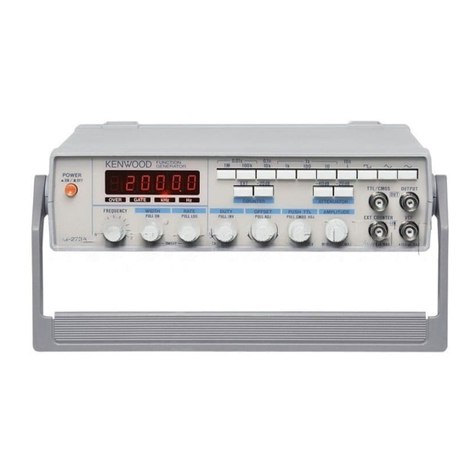
Kenwood
Kenwood FG-273 instruction manual
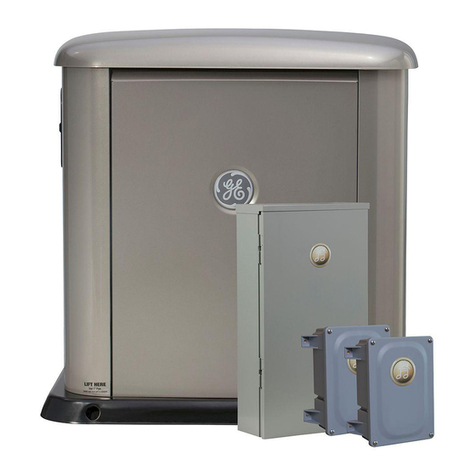
GE
GE HOME NERATOR SYSTEM 11000 WATT Operator's manual
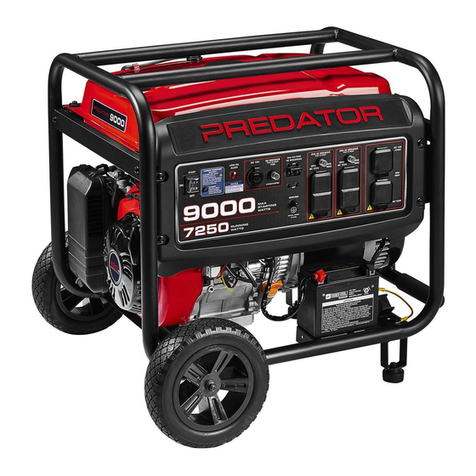
Harbor Freight Tools
Harbor Freight Tools PREDATOR 59206 Owner's manual & safety instructions
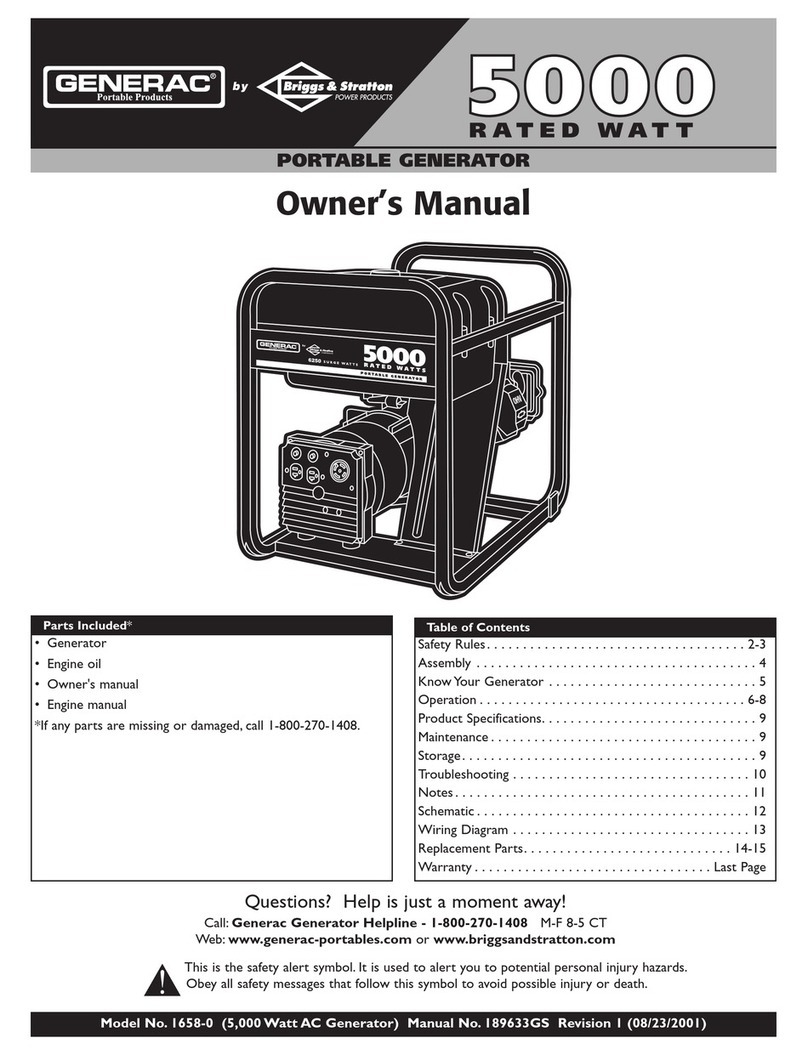
Generac Power Systems
Generac Power Systems Portable Generator user guide

Briggs & Stratton
Briggs & Stratton 030430 Service and repair manual
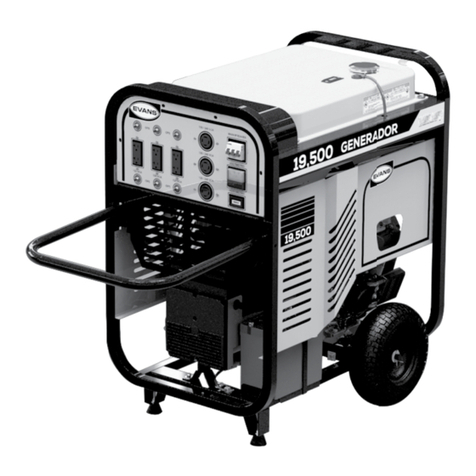
Evans
Evans VANGUARD G185MG3500BS owner's manual


